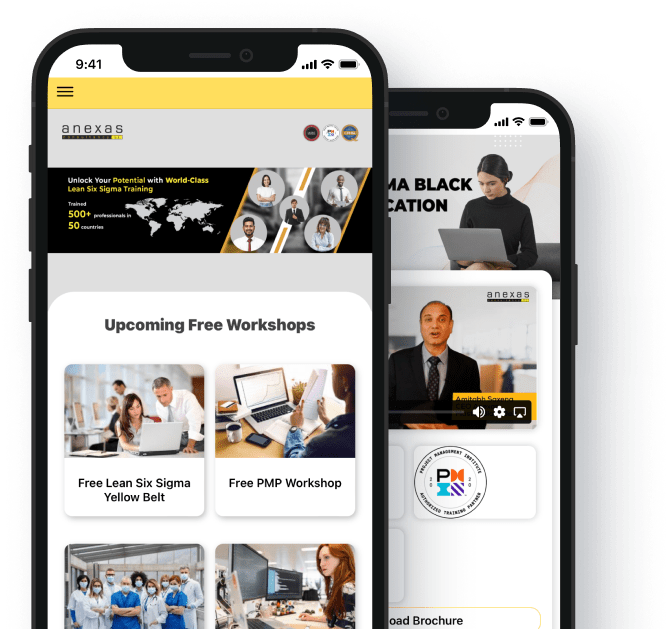Strategies for Engaging Employees and Fostering Continuous Improvement
- By Amitabh Saxena
- 28916 views
Table of Contents
Share This Article

Introduction to Strategies for Engaging Employees and Fostering Continuous Improvement
Definition of Lean Six Sigma
Lean Six Sigma is a robust, data-driven methodology aimed at improving efficiency and quality in business processes by eliminating waste and reducing variability.
- Explanation of Lean principles: Lean principles focus on maximizing customer value while minimizing waste, thereby creating more value with fewer resources. Originating from the Toyota Production System, Lean emphasizes five core principles: defining value from the customer’s perspective, mapping the value stream to identify and eliminate waste, creating continuous flow to ensure smooth production, establishing pull systems based on customer demand, and pursuing perfection through continuous improvement. The primary goal is to enhance process efficiency and effectiveness by streamlining operations, reducing cycle times, and improving overall productivity.
- Explanation of Six Sigma methodology: Six Sigma is a data-driven approach and methodology for eliminating defects and improving quality in any process, from manufacturing to transactional and from product to service. Six Sigma uses statistical tools and techniques to identify the root causes of defects and variability in processes and systematically remove them. The methodology follows the DMAIC framework: Define, Measure, Analyze, Improve, and Control. This structured approach ensures that improvements are data-driven and sustainable, leading to significant enhancements in quality, performance, and customer satisfaction.
Importance of Lean Six Sigma in modern business
In today’s highly competitive and fast-paced business environment, the importance of Lean Six Sigma cannot be overstated. Companies are under constant pressure to deliver high-quality products and services while keeping costs low and meeting stringent customer demands. Lean Six Sigma provides a comprehensive toolkit for achieving these objectives by fostering a culture of continuous improvement and operational excellence. It enables organizations to streamline their processes, eliminate waste, reduce defects, and improve efficiency, resulting in cost savings, higher profitability, and enhanced customer satisfaction. Moreover, Lean Six Sigma empowers employees by involving them in problem-solving and decision-making processes, thereby increasing their engagement and commitment to organizational goals.
Purpose of the outline: Strategies for engaging employees and fostering continuous improvement
The purpose of this outline is to provide a detailed roadmap for building a Lean Six Sigma culture within an organization. It focuses on strategies for engaging employees and fostering a mindset of continuous improvement. By leveraging Lean Six Sigma principles and methodologies, organizations can create an environment where employees are motivated and empowered to contribute to process improvements. This outline covers key areas such as leadership commitment, training and development, communication, recognition, and the implementation of structured improvement processes. Additionally, it addresses common challenges and provides case studies and best practices to illustrate successful Lean Six Sigma implementations. The ultimate goal is to equip organizations with the knowledge and tools needed to build a sustainable Lean Six Sigma culture that drives ongoing improvement and long-term success.
Understanding Lean Six Sigma Culture
Key elements of Lean Six Sigma culture
Building a Lean Six Sigma culture involves instilling key elements that drive the philosophy and practices across the organization, ensuring that they permeate every level and function.
1. Customer focus
A central tenet of Lean Six Sigma culture is a relentless focus on the customer. This principle dictates that all improvements and process optimizations should ultimately enhance customer satisfaction. Understanding customer needs and preferences is paramount, and this often involves gathering and analyzing customer feedback, mapping customer journeys, and aligning products and services to meet or exceed customer expectations. This focus ensures that the organization remains aligned with its market demands and continues to deliver value to its customers.
2. Data-driven decision making
Data-driven decision making is another crucial element of Lean Six Sigma culture. Decisions within the organization are based on empirical data and statistical analysis rather than intuition or guesswork. This approach involves collecting relevant data, analyzing it to uncover insights, and using these insights to guide strategic and operational decisions. By relying on data, organizations can identify root causes of issues, measure process performance accurately, and predict the impact of changes, thereby making informed and effective decisions that drive improvements and enhance overall efficiency.
3. Continuous improvement
Continuous improvement, often encapsulated in the Japanese concept of Kaizen, is a fundamental aspect of Lean Six Sigma culture. It emphasizes the need for ongoing efforts to improve processes, products, and services incrementally. This mindset encourages employees at all levels to constantly seek ways to enhance performance, reduce waste, and increase quality. Tools and techniques such as PDCA (Plan-Do-Check-Act) cycles, root cause analysis, and brainstorming sessions are commonly used to facilitate continuous improvement. By fostering a culture of continuous improvement, organizations can adapt more quickly to changes, maintain competitive advantage, and achieve long-term success.
4. Employee involvement
Employee involvement is critical to the success of Lean Six Sigma initiatives. This element emphasizes the importance of engaging employees in the improvement process by empowering them to take ownership of their work and contribute ideas for enhancing processes. When employees are actively involved, they are more likely to be motivated, committed, and aligned with organizational goals. Lean Six Sigma encourages the formation of cross-functional teams, regular feedback sessions, and recognition programs to acknowledge contributions. This inclusive approach not only drives better outcomes but also fosters a collaborative and innovative work environment where everyone feels valued and invested in the organization’s success.

Benefits of Lean Six Sigma culture
1. Enhanced efficiency and productivity
One of the most significant benefits of adopting a Lean Six Sigma culture is the substantial improvement in efficiency and productivity. Lean Six Sigma methodologies focus on streamlining processes, eliminating non-value-added activities, and optimizing workflows. This leads to faster turnaround times, reduced cycle times, and more efficient use of resources. By continually analyzing and refining processes, organizations can achieve higher output levels with the same or fewer inputs. This not only boosts productivity but also allows the company to respond more swiftly to market demands and changes, enhancing its competitive edge.
2. Reduced waste and costs
A core objective of Lean Six Sigma is the identification and elimination of waste in all its forms, which includes defects, overproduction, waiting, non-utilized talent, transportation, inventory, motion, and extra-processing. By rigorously analyzing processes and eliminating these wastes, organizations can significantly reduce operational costs. The systematic approach of Six Sigma ensures that quality issues are addressed at the root cause, preventing recurrence and thereby reducing costs associated with rework, scrap, and warranty claims. Lean principles further contribute by optimizing resource utilization and minimizing excess inventory, leading to a leaner, more cost-effective operation.
3. Improved quality and customer satisfaction
Improved quality is a hallmark of a Lean Six Sigma culture. By focusing on defect reduction and process improvement, Lean Six Sigma enhances the consistency and reliability of products and services. The DMAIC (Define, Measure, Analyze, Improve, Control) framework ensures that any changes made lead to measurable improvements in quality. As a result, customers receive products and services that meet or exceed their expectations, which significantly boosts customer satisfaction. High-quality offerings reduce the likelihood of customer complaints and returns, fostering customer loyalty and positive word-of-mouth, which are critical for long-term business success.
4. Increased employee satisfaction and retention
A Lean Six Sigma culture positively impacts employee satisfaction and retention. By involving employees in continuous improvement initiatives, organizations empower their workforce and foster a sense of ownership and pride in their work. Employees are given the tools and training to identify problems and contribute to solutions, which enhances their skills and job satisfaction. The recognition and rewards associated with successful Lean Six Sigma projects further motivate employees and reinforce their commitment to the organization. Additionally, a focus on efficiency reduces frustration caused by redundant or inefficient processes, leading to a more pleasant and productive work environment. This comprehensive approach not only retains talent but also attracts new employees who are eager to work in a progressive and innovative company.
Strategies for Engaging Employees
Leadership Commitment and Support
1. Role of leadership in setting the vision
The role of leadership in setting the vision is paramount when building a Lean Six Sigma culture. Leaders must articulate a clear and compelling vision that aligns with the principles of Lean Six Sigma and resonates with the entire organization. This vision should emphasize the importance of continuous improvement, operational excellence, and a relentless focus on customer satisfaction. Effective leaders communicate this vision consistently and persuasively, ensuring that all employees understand the strategic goals and their roles in achieving them. By setting the vision, leaders create a sense of purpose and direction that motivates and engages employees, fostering a unified commitment to Lean Six Sigma initiatives.
2. Demonstrating commitment through actions and resources
Demonstrating commitment through actions and resources is crucial for gaining employee buy-in and sustaining momentum in Lean Six Sigma efforts. Leaders must go beyond verbal endorsements and actively participate in Lean Six Sigma activities. This includes attending training sessions, participating in improvement projects, and visibly supporting Lean Six Sigma events such as Kaizen workshops and Gemba walks. By being present and involved, leaders show that they are genuinely committed to the process and value the contributions of their teams. Additionally, allocating adequate resources is essential. This means providing the necessary tools, training, and time for employees to effectively engage in Lean Six Sigma activities. Investment in specialized software, continuous education, and hiring or developing Lean Six Sigma experts demonstrates that the organization is serious about embedding these principles into its operations. Leaders should also establish a supportive infrastructure, including dedicated Lean Six Sigma teams or offices, to coordinate and drive initiatives. By backing their vision with tangible actions and resources, leaders can build trust, inspire confidence, and foster a culture of continuous improvement where employees feel valued and empowered to contribute to the organization’s success.
Training and Development
1. Comprehensive Lean Six Sigma training programs
Comprehensive Lean Six Sigma training programs are foundational for equipping employees with the knowledge and skills necessary to effectively implement and sustain Lean Six Sigma initiatives. These programs typically start with introductory courses that cover the basics of Lean and Six Sigma principles, methodologies, and tools. As employees progress, they engage in more advanced training that delves deeper into specific techniques such as value stream mapping, root cause analysis, statistical process control, and the DMAIC (Define, Measure, Analyze, Improve, Control) framework. Training should be tailored to different roles within the organization, from frontline workers to managers and executives, ensuring that everyone understands their part in the Lean Six Sigma process. Practical, hands-on training, including simulations, case studies, and real-world projects, helps employees apply what they have learned in their everyday work. By providing comprehensive training, organizations create a knowledgeable workforce that can identify inefficiencies, solve problems, and drive continuous improvement.
2. Ongoing education and certification opportunities
Ongoing education and certification opportunities are crucial for maintaining and advancing Lean Six Sigma expertise within the organization. Continuous learning keeps employees updated on the latest Lean Six Sigma developments, methodologies, and best practices. Offering a variety of educational formats, such as workshops, webinars, and online courses, caters to different learning preferences and schedules. Certification programs, such as Yellow Belt, Green Belt, Black Belt, and Master Black Belt, provide structured paths for employees to deepen their expertise and take on more significant roles in Lean Six Sigma initiatives. These certifications not only recognize and validate the skills and knowledge of employees but also motivate them to pursue further professional development. Additionally, supporting employees in attending industry conferences, seminars, and networking events helps them stay connected with the broader Lean Six Sigma community, exchange ideas, and bring back innovative practices to their organization. By fostering a culture of continuous learning and providing clear pathways for career advancement through certification, organizations can retain top talent, drive sustained improvement, and build a robust internal capacity for Lean Six Sigma excellence.

Communication and Transparency
1. Regular updates on Lean Six Sigma initiatives and progress
Effective communication and transparency are critical for fostering a Lean Six Sigma culture within an organization. Regular updates on Lean Six Sigma initiatives and progress ensure that all employees are informed about the ongoing efforts and achievements. These updates can take various forms, including newsletters, intranet posts, town hall meetings, and progress dashboards. They should highlight key milestones, successful projects, and the overall impact of Lean Six Sigma on the organization’s performance. By consistently sharing this information, leaders demonstrate the importance of Lean Six Sigma and reinforce its relevance to the organization’s goals. Additionally, these updates help maintain momentum and motivation, as employees see the tangible results of their efforts and understand how their contributions fit into the bigger picture. Transparency in communication also builds trust, as it shows that the organization is open about its challenges and successes, fostering a culture where continuous improvement is valued and celebrated.
2. Open forums for feedback and suggestions
Open forums for feedback and suggestions are another vital component of effective communication and transparency in a Lean Six Sigma culture. These forums provide a platform for employees to share their insights, ideas, and concerns about Lean Six Sigma initiatives. They can be structured as regular meetings, online suggestion boxes, or interactive workshops. Encouraging open dialogue and actively soliciting input from employees helps identify potential issues early and uncovers innovative solutions that might not have been considered by leadership alone. It also empowers employees by giving them a voice in the continuous improvement process, making them feel valued and engaged. Leaders should ensure that feedback is taken seriously, acted upon, and communicated back to the employees, creating a loop of continuous engagement and improvement. This practice not only enhances the effectiveness of Lean Six Sigma initiatives but also fosters a collaborative environment where everyone is committed to achieving operational excellence.
Recognition and Rewards
1. Acknowledging individual and team contributions
Recognition and rewards play a crucial role in fostering a Lean Six Sigma culture by acknowledging the efforts and achievements of individuals and teams. Acknowledging contributions can take many forms, from formal awards and public recognition at company meetings to personalized thank-you notes and informal praise. Highlighting individual accomplishments, such as successfully leading a Lean Six Sigma project or significantly improving a process, not only boosts the morale of the recognized employee but also sets a positive example for others. Similarly, recognizing the collective efforts of teams reinforces the importance of collaboration and shared success in achieving Lean Six Sigma goals. This recognition should be timely and specific, detailing what was achieved and why it is important, to ensure that employees understand the value of their contributions. By consistently acknowledging efforts and successes, organizations can cultivate a motivated and engaged workforce that is committed to continuous improvement.
2. Creating incentive programs tied to Lean Six Sigma achievements
Creating incentive programs tied to Lean Six Sigma achievements further strengthens the culture of continuous improvement. These programs can include financial rewards, such as bonuses or profit-sharing for significant improvements in efficiency or quality, as well as non-financial incentives like additional vacation days, professional development opportunities, or career advancement prospects. Incentive programs should be designed to align with the organization’s Lean Six Sigma goals, encouraging employees to focus on areas that will have the most significant impact. For example, rewards might be given for reducing waste, cutting costs, improving customer satisfaction, or completing certifications like Green Belt or Black Belt. It’s important that these incentives are perceived as attainable and fair, with clear criteria and transparent evaluation processes. By linking rewards directly to Lean Six Sigma achievements, organizations can drive performance and innovation, making continuous improvement an integral part of the corporate culture.
Empowerment and Involvement
1. Encouraging employee ownership of processes
Empowerment and involvement are pivotal in building a Lean Six Sigma culture, and this starts with encouraging employee ownership of processes. When employees feel a sense of ownership, they are more invested in the success of the processes they manage and are more likely to seek out and implement improvements. Organizations can foster this ownership by providing employees with the authority and autonomy to make decisions about their work. This can be achieved through training that equips them with the necessary skills and knowledge to understand and optimize their processes, and through a culture that values and trusts employee input. By involving employees in the goal-setting and planning stages of Lean Six Sigma projects, organizations can ensure that they feel responsible for the outcomes. This not only enhances their commitment to continuous improvement but also leverages their firsthand experience and insights to identify areas for enhancement that may not be visible to management.
2. Involving employees in problem-solving teams and Kaizen events
Involving employees in problem-solving teams and Kaizen events is another critical aspect of empowerment and involvement. Kaizen events, which are focused, short-term projects aimed at improving specific processes, provide an excellent opportunity for employees to collaborate on problem-solving. By participating in these events, employees can contribute their unique perspectives and expertise to diagnose issues, brainstorm solutions, and implement changes. This collaborative approach not only leads to more effective and innovative solutions but also reinforces a culture of teamwork and shared responsibility. Similarly, forming cross-functional problem-solving teams helps to break down silos and encourages the sharing of knowledge and best practices across different areas of the organization. Employees who participate in these teams gain valuable experience in Lean Six Sigma methodologies and develop a deeper understanding of how their work impacts the broader organization. This hands-on involvement fosters a sense of pride and accomplishment, further motivating employees to engage in continuous improvement efforts.

Fostering Continuous Improvement
Establishing a Continuous Improvement Mindset
1. Promoting the idea that improvement is ongoing
Fostering continuous improvement within an organization begins with promoting the idea that improvement is an ongoing process, not a one-time effort. This mindset shift requires a fundamental change in how employees perceive their work and their role in the organization. Leaders can promote this idea by consistently communicating that perfection is not the end goal, but rather the relentless pursuit of better ways to do things. This can be done through regular training sessions, workshops, and internal communications that highlight the successes and learnings from past improvement initiatives. By celebrating small wins and recognizing incremental progress, leaders can reinforce the notion that every effort towards improvement, no matter how small, is valuable. Additionally, embedding the concept of ongoing improvement into daily routines—such as incorporating brief improvement discussions in team meetings or encouraging employees to spend a portion of their time identifying and working on process improvements—can help normalize this mindset.
2. Embedding continuous improvement in the company’s mission and values
Embedding continuous improvement in the company’s mission and values is critical for ensuring that this mindset becomes a core aspect of the organizational culture. The company’s mission statement should explicitly reflect a commitment to continuous improvement, quality, and innovation. This strategic alignment ensures that all employees, from top management to frontline workers, understand that continuous improvement is a priority and a shared responsibility. Values that emphasize learning, adaptability, and excellence can guide behaviors and decision-making processes across the organization. To reinforce these values, leaders should model continuous improvement behaviors themselves and provide clear expectations and guidelines for employees. Policies and performance metrics should also align with these values, rewarding behaviors that contribute to continuous improvement. Training programs, onboarding processes, and leadership development initiatives should all include components that emphasize the importance of continuous improvement. Furthermore, creating an environment that encourages experimentation and accepts failure as a learning opportunity can help embed these values deeply within the organizational fabric. By making continuous improvement a fundamental part of the company’s mission and values, organizations can ensure that it becomes a driving force behind all activities, fostering a culture where every employee is motivated to contribute to ongoing enhancements in processes, products, and services.
Implementing Structured Improvement Processes
1. PDCA (Plan-Do-Check-Act) cycle
Implementing structured improvement processes is crucial for ensuring that continuous improvement efforts are systematic, measurable, and sustainable. One such method is the PDCA (Plan-Do-Check-Act) cycle, also known as the Deming cycle. The PDCA cycle consists of four stages: Plan, Do, Check, and Act. In the Plan phase, teams identify areas for improvement, set objectives, and develop action plans. During the Do phase, teams implement the planned changes on a small scale to test their effectiveness. The Check phase involves evaluating the results of the implemented changes through data analysis and comparison against the initial objectives. Based on the findings, adjustments are made in the Act phase, and the cycle repeats to further refine the process. The PDCA cycle provides a structured framework for iterative improvement, allowing organizations to continuously test, learn, and adapt their approaches to achieve better outcomes.
2. DMAIC (Define, Measure, Analyze, Improve, Control) framework
Another structured improvement process widely used in Lean Six Sigma is the DMAIC (Define, Measure, Analyze, Improve, Control) framework. DMAIC is a data-driven approach for identifying and eliminating defects or inefficiencies in existing processes. In the Define phase, teams clarify the problem, define project goals, and establish project scope. The Measure phase involves quantifying the current state of the process and identifying key metrics to track improvement. In the Analyze phase, teams analyze data to identify root causes of issues and prioritize improvement opportunities. The Improve phase focuses on implementing solutions to address identified root causes and improve process performance. Finally, the Control phase ensures that improvements are sustained over time by implementing control measures and monitoring performance. The DMAIC framework provides a systematic approach to problem-solving, guiding teams through each step of the improvement process and ensuring that changes are based on data and analysis. By following the DMAIC framework, organizations can effectively identify, address, and prevent issues, leading to continuous improvement and enhanced performance.
Leveraging Data and Metrics
1. Importance of data collection and analysis
Leveraging data and metrics is essential for driving continuous improvement within an organization. Data collection and analysis provide valuable insights into the performance of processes, enabling organizations to identify areas for improvement and make data-driven decisions. By systematically collecting data on key process parameters, organizations can gain a deeper understanding of how their processes are performing and where inefficiencies may exist. This data can include various types of information, such as cycle times, defect rates, customer feedback, and resource utilization. Through thorough analysis of this data, organizations can uncover patterns, trends, and root causes of issues, allowing them to prioritize improvement efforts effectively. Data-driven decision-making ensures that improvements are targeted and based on evidence, rather than guesswork or intuition, increasing the likelihood of success and sustainability.
2. Using metrics to track progress and identify improvement areas
Metrics play a vital role in tracking progress and identifying improvement areas throughout the continuous improvement journey. By establishing clear, measurable metrics aligned with organizational goals, organizations can monitor the effectiveness of improvement initiatives and assess their impact on overall performance. These metrics can include both leading indicators, such as process cycle times or defect rates, and lagging indicators, such as customer satisfaction scores or financial performance metrics. Regularly tracking and analyzing these metrics allows organizations to identify trends, monitor performance against targets, and proactively address any deviations or issues that arise. Moreover, metrics provide visibility into the effectiveness of improvement efforts, allowing organizations to celebrate successes and course-correct as needed. By using metrics to track progress and identify improvement areas, organizations can ensure that their continuous improvement efforts are focused, data-driven, and aligned with strategic objectives, leading to sustained performance improvement and organizational success.

Developing a Feedback Loop
1. Regular review and reflection sessions
Developing a feedback loop is essential for fostering continuous improvement within an organization. Regular review and reflection sessions provide opportunities for teams to assess the effectiveness of their improvement efforts, identify lessons learned, and make adjustments as needed. These sessions can take various forms, such as weekly progress meetings, post-project reviews, or quarterly performance evaluations. During these sessions, teams review the results of their improvement initiatives, compare them against established goals and metrics, and discuss any challenges or obstacles encountered. By openly sharing successes and failures, teams can learn from each other’s experiences and brainstorm new ideas for improvement. These sessions also serve as a forum for celebrating achievements and recognizing the contributions of team members, fostering a culture of appreciation and collaboration. Through regular review and reflection, organizations can continuously refine their approach to improvement, ensuring that they remain agile and responsive to changing needs and circumstances.
2. Incorporating feedback into improvement plans
Incorporating feedback into improvement plans is essential for ensuring that continuous improvement efforts are targeted and effective. Feedback can come from various sources, including frontline employees, customers, stakeholders, and performance metrics. By actively soliciting and listening to feedback, organizations can gain valuable insights into areas for improvement and potential solutions. This feedback should be incorporated into improvement plans, guiding the development of strategies and actions to address identified issues. Teams should prioritize feedback based on its impact and feasibility, focusing on initiatives that have the potential to deliver the greatest value to the organization. Additionally, organizations should establish mechanisms for tracking the implementation of feedback-driven improvements and measuring their impact over time. By closing the loop and demonstrating that feedback is valued and acted upon, organizations can foster a culture of continuous improvement and engagement, driving ongoing performance enhancement and organizational success.
Sustaining Improvements
1. Standardizing successful practices
Sustaining improvements is crucial for ensuring that the benefits of continuous improvement efforts are realized over the long term. One key strategy for sustaining improvements is to standardize successful practices. After identifying and implementing successful improvement initiatives, organizations should document these practices and establish standard operating procedures (SOPs) to ensure consistency and repeatability. SOPs provide clear guidelines and instructions for carrying out tasks and processes, reducing variability and minimizing the risk of regression to previous, less efficient methods. Standardization also facilitates training and onboarding of new employees, ensuring that they are equipped with the knowledge and tools needed to maintain and build upon the improvements achieved by their predecessors. By institutionalizing successful practices through standardization, organizations can embed continuous improvement into their daily operations and ensure that gains are sustained over time.
2. Ensuring continuous monitoring and adjustment
In addition to standardizing successful practices, ensuring continuous monitoring and adjustment is essential for sustaining improvements. Continuous monitoring involves regularly tracking key performance metrics and indicators to assess the effectiveness of improvement initiatives and identify any deviations from expected outcomes. This monitoring should be accompanied by ongoing analysis to understand the root causes of any issues or variations and to inform necessary adjustments. Organizations should establish robust systems and processes for collecting and analyzing data, as well as mechanisms for disseminating insights and recommendations to relevant stakeholders. Based on this analysis, organizations can make informed decisions about whether further adjustments or refinements are needed to maintain or enhance the performance of processes. By continuously monitoring and adjusting improvement initiatives, organizations can adapt to changing conditions and requirements, ensuring that improvements remain relevant and effective in the face of evolving challenges and opportunities.
Overcoming Challenges
Resistance to Change
1. Understanding the root causes of resistance
Resistance to change is a common challenge encountered when implementing Lean Six Sigma initiatives, as it often involves significant shifts in processes, roles, and organizational culture. Understanding the root causes of resistance is essential for effectively addressing and mitigating it. Resistance can stem from various sources, including fear of the unknown, perceived threats to job security or status quo, lack of understanding or buy-in, and past negative experiences with change efforts. By conducting thorough assessments and engaging in open dialogue with employees, leaders can gain insights into the underlying reasons for resistance. This may involve conducting surveys, focus groups, or one-on-one interviews to gather feedback and perspectives from different stakeholders. By understanding the root causes of resistance, organizations can tailor their change management strategies to address specific concerns and overcome barriers to adoption.
2. Strategies for addressing and mitigating resistance
Once the root causes of resistance have been identified, organizations can implement strategies to address and mitigate resistance effectively. One approach is to provide clear and transparent communication about the reasons for change, the expected benefits, and how employees will be impacted. Leaders should emphasize the importance of the change in achieving organizational goals and highlight the opportunities for personal and professional growth that it presents. Additionally, involving employees in the change process through participation in decision-making, problem-solving, and change planning can help build ownership and commitment. Providing adequate support and resources, such as training, coaching, and mentoring, can also help employees feel more confident and capable in navigating the change. Furthermore, recognizing and celebrating early adopters and champions of change can help shift the culture towards acceptance and enthusiasm for Lean Six Sigma initiatives. By implementing a combination of these strategies, organizations can overcome resistance to change and create a supportive environment conducive to successful Lean Six Sigma implementation.
Balancing Short-Term and Long-Term Goals
1. Aligning Lean Six Sigma with business objectives
Balancing short-term and long-term goals is essential for successful Lean Six Sigma implementation, as organizations must ensure alignment with overarching business objectives. To achieve this alignment, it is crucial to clearly define the strategic priorities and goals of the organization and identify how Lean Six Sigma initiatives can support and contribute to these objectives. This may involve conducting a thorough analysis of the current state of the organization, identifying areas of opportunity for improvement, and prioritizing initiatives based on their potential impact on business performance. By aligning Lean Six Sigma initiatives with business objectives, organizations can ensure that resources are allocated effectively and that efforts are focused on areas that will deliver the greatest value to the organization in both the short and long term.
2. Ensuring quick wins while focusing on long-term gains
While it is important to focus on long-term gains, organizations must also ensure that they achieve quick wins to maintain momentum and demonstrate the value of Lean Six Sigma initiatives. Quick wins refer to relatively small-scale improvements that deliver tangible results within a short timeframe, typically a few weeks to a few months. These quick wins serve as proof of concept, providing evidence that Lean Six Sigma methodologies can deliver measurable improvements in performance and efficiency. To ensure quick wins, organizations should prioritize initiatives that are relatively straightforward to implement, have a high likelihood of success, and deliver visible benefits to key stakeholders. By achieving quick wins, organizations can build confidence in Lean Six Sigma among employees and leadership, garnering support for broader and more complex improvement initiatives over the long term. Additionally, quick wins help generate enthusiasm and engagement among employees, motivating them to actively participate in future improvement efforts. However, it is essential to strike a balance between pursuing quick wins and maintaining a focus on long-term goals, ensuring that short-term successes contribute to the overall strategic objectives of the organization.

Resource Allocation
1. Ensuring adequate resources for Lean Six Sigma initiatives
Resource allocation is a critical challenge in Lean Six Sigma implementation, as organizations must ensure they have the necessary resources to support their improvement initiatives effectively. This includes financial resources for training, software, and other tools, as well as human resources in the form of dedicated teams or personnel with expertise in Lean Six Sigma methodologies. Adequate resources are essential for ensuring that improvement projects are executed efficiently and that teams have the support they need to succeed. Organizations should carefully assess their resource needs based on the scale and scope of their Lean Six Sigma initiatives and allocate resources accordingly. This may involve securing buy-in from senior leadership and advocating for the necessary resources to support Lean Six Sigma efforts. Additionally, organizations should continuously monitor resource utilization and adjust allocations as needed to ensure that teams have access to the resources required to achieve their objectives.
2. Prioritizing projects based on impact and feasibility
In addition to ensuring adequate resources, organizations must prioritize projects based on their potential impact and feasibility. Not all improvement projects will deliver the same level of value or be equally feasible to implement, so organizations must carefully evaluate and prioritize projects based on their expected return on investment, alignment with strategic objectives, and feasibility of implementation. Projects with the potential to deliver significant cost savings, improve customer satisfaction, or streamline critical processes should be given priority, as should projects that can be implemented relatively quickly and with minimal disruption to existing operations. Organizations can use various prioritization techniques, such as cost-benefit analysis, risk assessment, and stakeholder input, to determine which projects to pursue. By prioritizing projects based on impact and feasibility, organizations can focus their resources on initiatives that will deliver the greatest value and drive meaningful improvements in performance and efficiency. This approach ensures that resource allocation is strategic and that organizations maximize the return on their investment in Lean Six Sigma initiatives.
Case Studies and Examples
Successful implementation of Lean Six Sigma in various industries
Successful implementation of Lean Six Sigma in various industries serves as valuable inspiration and learning opportunities for organizations embarking on their own improvement journeys. Case studies highlighting successful Lean Six Sigma implementations showcase how organizations across different sectors, such as manufacturing, healthcare, finance, and services, have achieved significant improvements in operational efficiency, quality, and customer satisfaction. For example, Toyota’s renowned Toyota Production System (TPS) demonstrates how Lean principles can revolutionize manufacturing processes, leading to reduced waste, improved productivity, and enhanced product quality. Similarly, healthcare organizations like Mayo Clinic have successfully applied Lean Six Sigma methodologies to streamline patient care processes, reduce wait times, and improve clinical outcomes. By studying these case studies, organizations can gain insights into the strategies, tools, and practices that have contributed to success in different industries, enabling them to adapt and apply similar approaches to their own improvement initiatives.
Lessons learned from failures and setbacks
While success stories provide valuable insights, lessons learned from failures and setbacks are equally important for organizations seeking to implement Lean Six Sigma effectively. Failure is an inevitable part of the improvement journey, and organizations must embrace failures as learning opportunities to identify areas for improvement and avoid repeating mistakes in the future. Case studies and examples of failed Lean Six Sigma implementations can help organizations understand common pitfalls, such as lack of leadership support, inadequate training, and resistance to change, and develop strategies to address these challenges proactively. For instance, the failure of the implementation of Lean Six Sigma at Motorola’s mobile phone division highlights the importance of aligning improvement initiatives with strategic objectives and ensuring ongoing leadership commitment and support. By studying failures and setbacks, organizations can gain a deeper understanding of the factors that contribute to success or failure in Lean Six Sigma implementations and develop strategies to mitigate risks and enhance the likelihood of success.
Best practices for sustaining a Lean Six Sigma culture
Best practices for sustaining a Lean Six Sigma culture provide organizations with guidance on how to maintain momentum and drive continuous improvement over the long term. Case studies and examples of organizations that have successfully sustained a Lean Six Sigma culture offer valuable insights into the strategies, behaviors, and practices that contribute to ongoing success. For example, General Electric (GE) is widely recognized for its commitment to Lean Six Sigma and its systematic approach to training, certification, and project selection. By embedding Lean Six Sigma principles into its organizational culture and operations, GE has been able to achieve significant improvements in quality, efficiency, and customer satisfaction across its diverse business units. Other best practices for sustaining a Lean Six Sigma culture include fostering leadership support and engagement, investing in ongoing training and development, recognizing and rewarding employee contributions, and establishing mechanisms for continuous monitoring and adjustment. By adopting these best practices, organizations can create a culture of continuous improvement that becomes ingrained in the fabric of the organization, driving sustained success and competitive advantage.
Conclusion
In conclusion, the journey towards building a Lean Six Sigma culture is multifaceted, requiring a strategic approach and commitment from all levels of an organization. Through the delineated strategies, including fostering employee engagement, leveraging structured improvement processes, harnessing the power of data, and sustaining improvements, organizations can cultivate an environment conducive to continuous improvement and operational excellence. However, challenges such as resistance to change, balancing short-term and long-term goals, and resource allocation must be navigated with care, drawing from insights gleaned from both successful implementations and lessons learned from setbacks. By embracing best practices and learning from both successes and failures, organizations can develop a robust Lean Six Sigma culture that not only drives efficiency, productivity, and quality but also fosters innovation and adaptability in an ever-evolving business landscape. Ultimately, a sustained commitment to continuous improvement ensures that organizations remain agile, responsive, and well-positioned to thrive in today’s competitive marketplace.

FAQ
What is Lean Six Sigma?
Lean Six Sigma is a methodology that combines principles from Lean manufacturing and Six Sigma to improve processes by systematically eliminating waste and reducing variation, ultimately leading to increased efficiency, quality, and customer satisfaction.
How does Lean Six Sigma differ from traditional Six Sigma?
While traditional Six Sigma focuses primarily on reducing defects and variation in processes, Lean Six Sigma incorporates Lean principles to also target and eliminate waste, making processes more efficient and streamlined.
What are the key principles of Lean Six Sigma?
The key principles of Lean Six Sigma include customer focus, data-driven decision-making, continuous improvement, employee involvement, and a focus on delivering value to the customer.
What are some common Lean Six Sigma tools and techniques?
Some common Lean Six Sigma tools and techniques include process mapping, value stream mapping, root cause analysis, DMAIC (Define, Measure, Analyze, Improve, Control) methodology, Kaizen events, and statistical analysis tools such as control charts and regression analysis.
How can Lean Six Sigma benefit my organization?
Lean Six Sigma can benefit organizations by improving efficiency, reducing waste and costs, enhancing product and service quality, increasing customer satisfaction, and fostering a culture of continuous improvement and innovation.
What are the roles and responsibilities in a Lean Six Sigma project?
In a Lean Six Sigma project, key roles may include executive sponsors who provide leadership and support, project champions who oversee project implementation, project managers who lead project teams, and team members who contribute to data collection, analysis, and solution implementation.
How long does it take to see results from Lean Six Sigma initiatives?
The timeline for seeing results from Lean Six Sigma initiatives can vary depending on the complexity of the project and the organization’s readiness for change. However, organizations often start to see measurable improvements within a few months to a year of implementing Lean Six Sigma initiatives.
How do you measure the success of Lean Six Sigma projects?
The success of Lean Six Sigma projects can be measured using key performance indicators (KPIs) such as cost savings, defect reduction, cycle time reduction, customer satisfaction scores, and return on investment (ROI).
What are some common challenges in implementing Lean Six Sigma?
Common challenges in implementing Lean Six Sigma include resistance to change, lack of leadership support, inadequate resources, difficulty in prioritizing projects, and sustaining improvements over the long term
How can I get started with Lean Six Sigma in my organization?
Getting started with Lean Six Sigma involves identifying opportunities for improvement, building awareness and buy-in among stakeholders, providing training and support for employees, selecting and prioritizing projects, and establishing a culture of continuous improvement and accountability.





